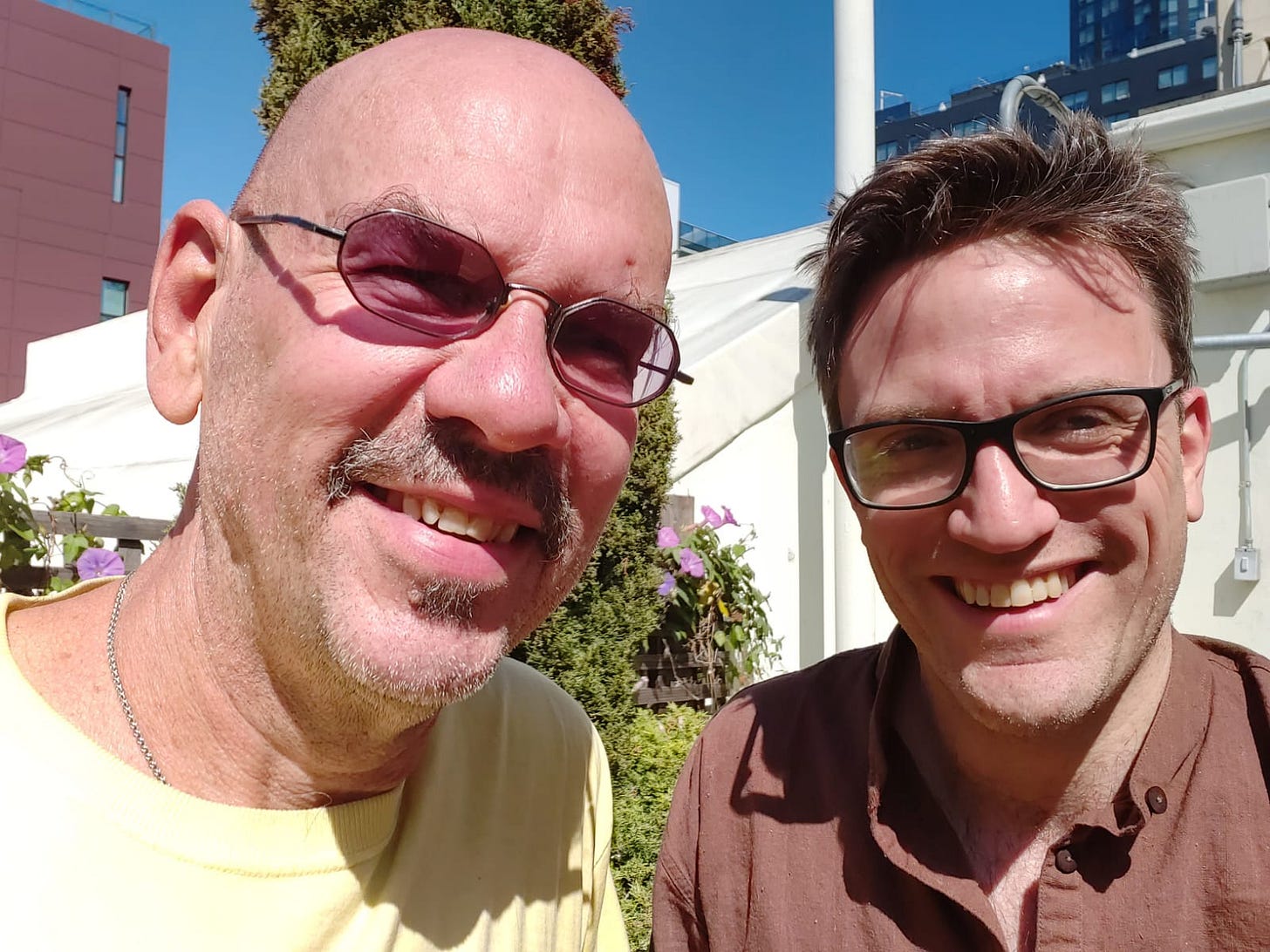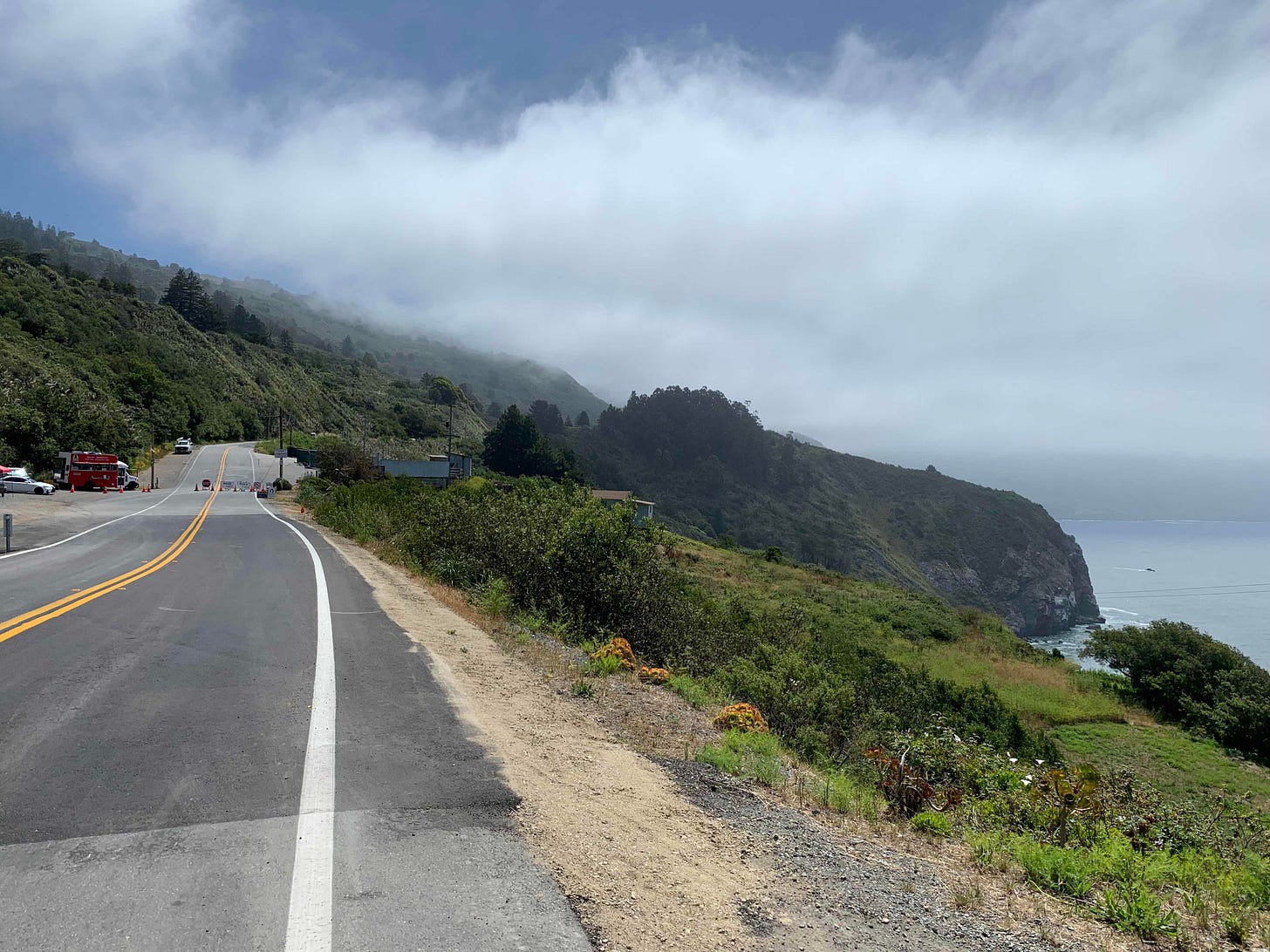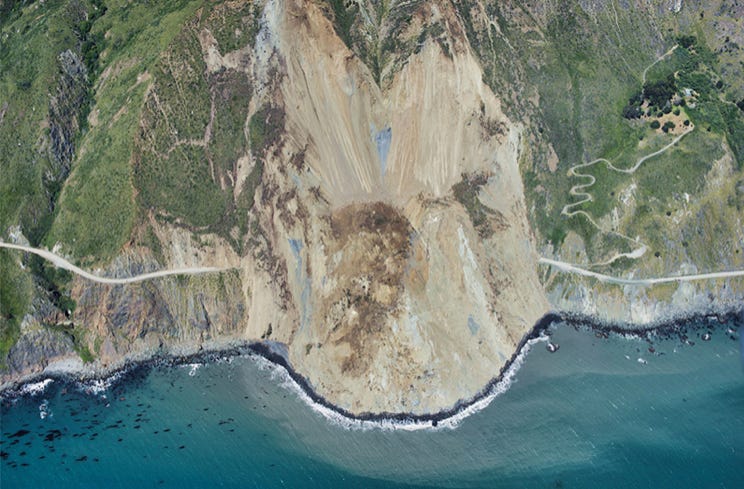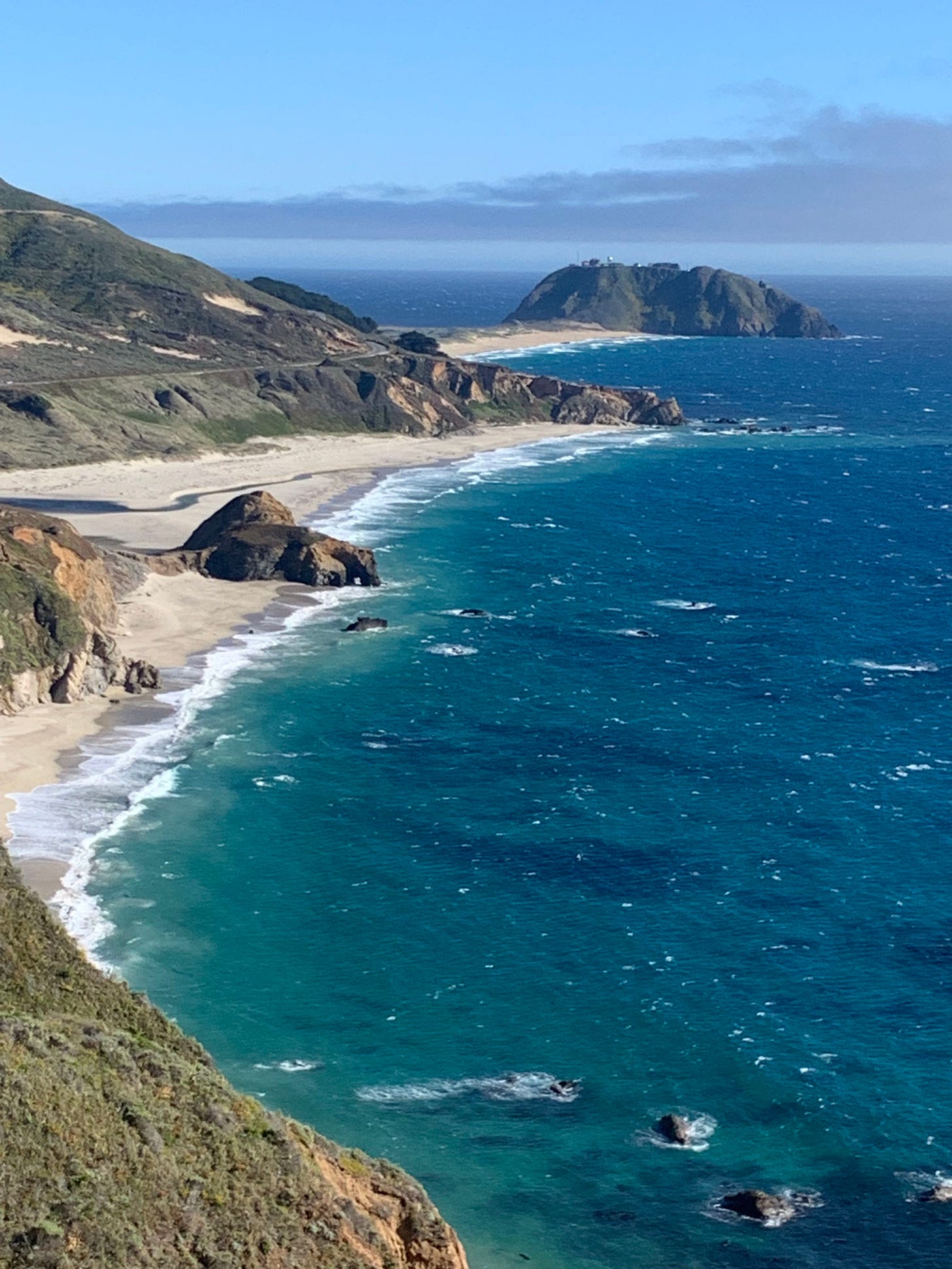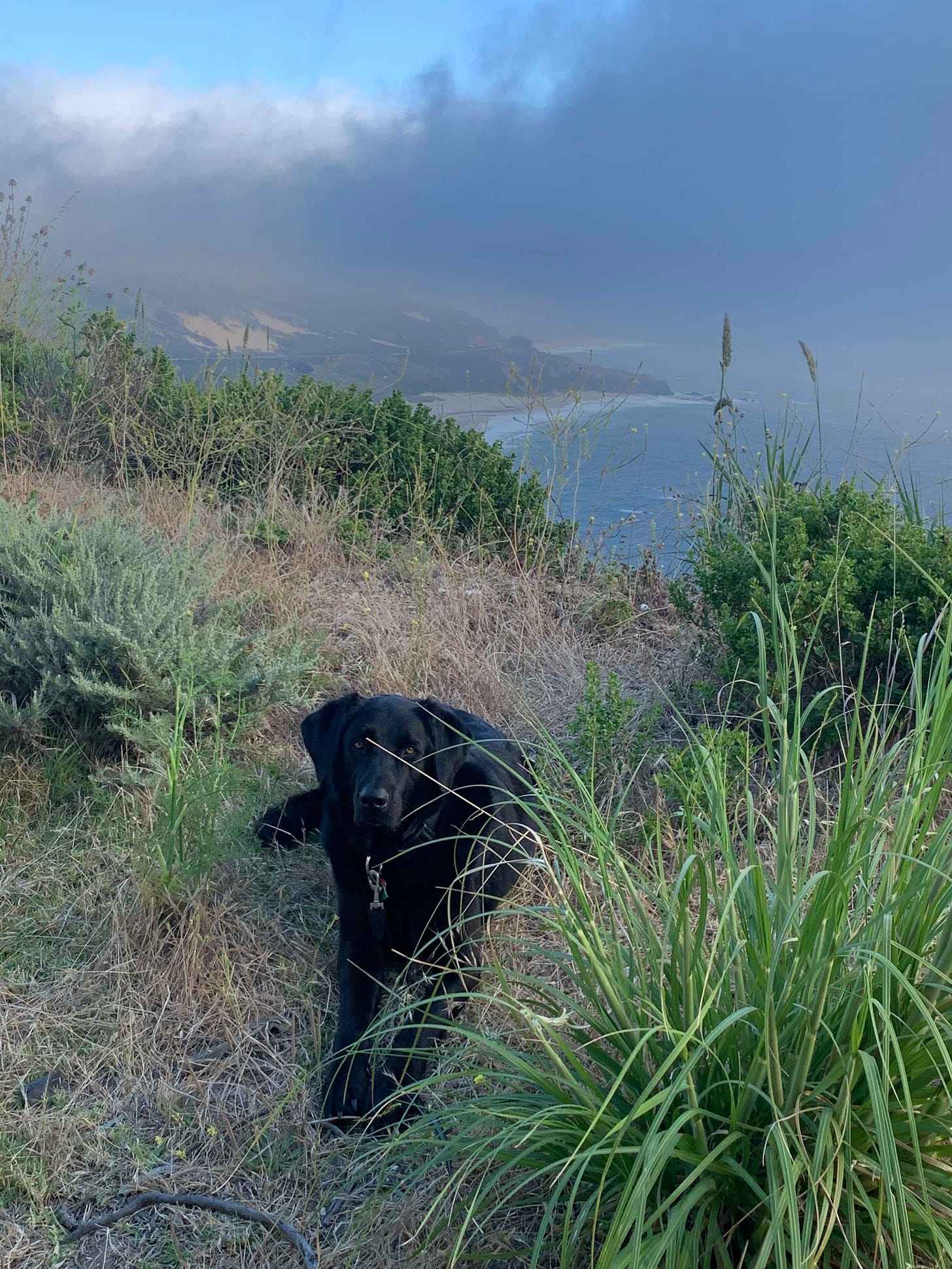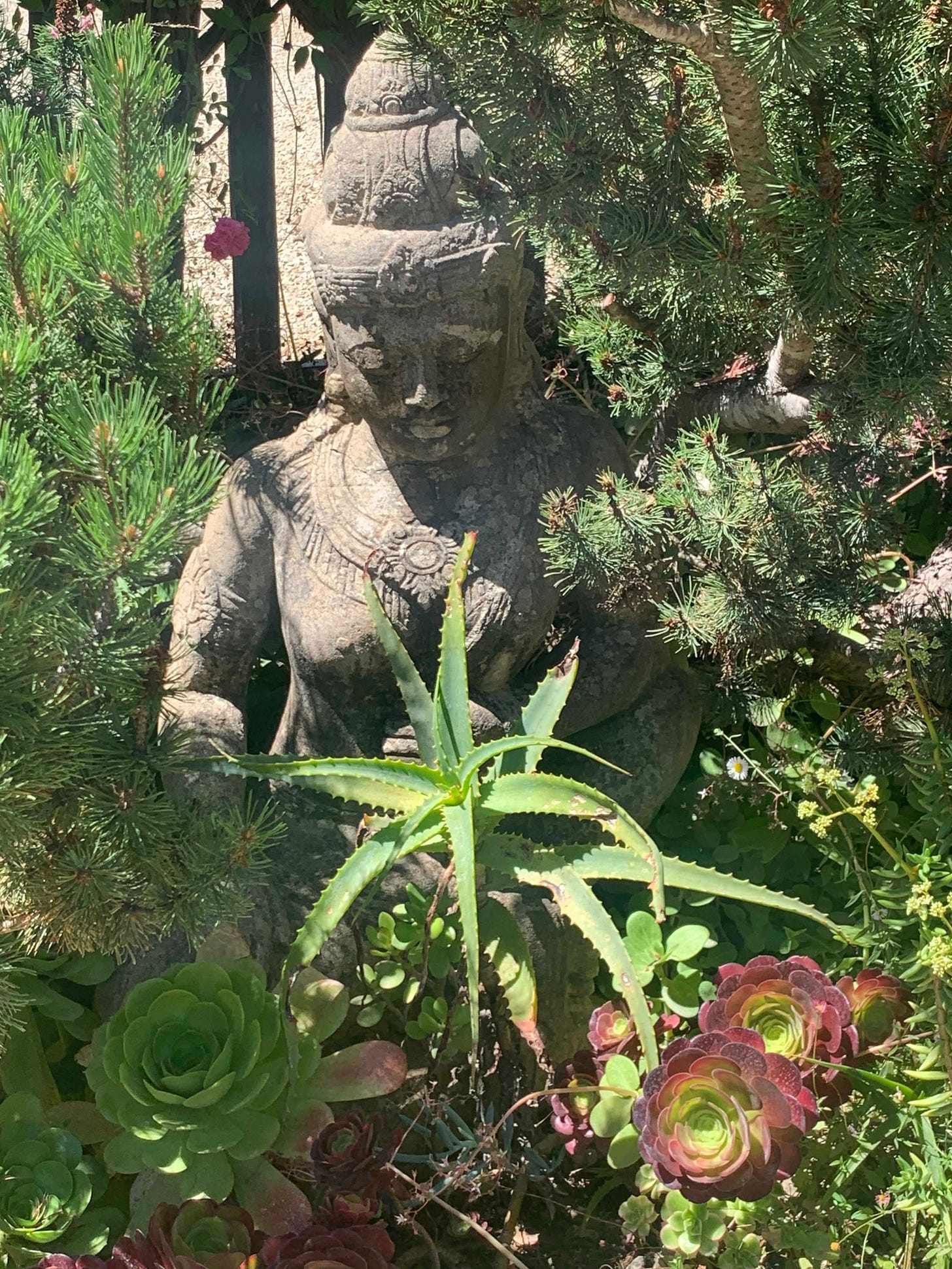Guest Post: The Mad Dharma Beat American Highway Dream
Zhiwa Woodbury's inaugural dispatch for his Dharma Beat newsletter reckons with the 'new abnormal' of our climate trauma.
Resonant World #37
For regular readers, Zhiwa Woodbury needs no introduction. We first spoke in early 2019, when I was working on a story on Extinction Rebellion for the Financial Times, and I’d stumbled across his seminal paper Climate Trauma: Towards a new taxonomy of traumatology in the journal Ecopsychology. (Resonant World #1).
The paper has been a big influence on me, and was part of the inspiration for launching Resonant World. More than that, getting to know Zhiwa, who I spent a few days with during my first and only visit to California in October, 2019, has been an endlessly rewarding — and enlightening — adventure in and of itself.
The below account chronicles Zhiwa’s recent trip up Highway One in his 2001 EuroVan Camper, accompanied by Rama, his black Labrador, and fresh from an encounter with the most esteemed Khadrola — Khandro Kunga Bhuma — the official state oracle of Tibet (and vessel for the protector goddess Tseringma). The journey was the first leg in a still-unfolding quest to integrate a lifetime of Dharma practice; career as a public interest attorney; decades of eco-activism; and his perspective as a panpsychologist to help us meet the climate crisis with wiser minds and more open hearts.
Zhiwa writes:
“Our destination is a healing place, an integral commune of spirit that is congealing around the world like a quantum virus from outer space.”
In this era of climate trauma, I’ll take whatever I can get.
I love Zhiwa’s writing as much as I love the man himself. Please do consider subscribing to his Dharma Beat newsletter to join what will be a wild, consciousness-expanding ride:
July 16, 2023
BIG SUR, California — Mother Nature bats last, as the doom-scrollers like to say. Visceral evidence of that truism can be found now at the end of Kerouac’s and Henry Miller’s American Dream Boulevard: the iconic cool jazz bebop Hwy 1, which snakes its way down the South Coast like an automated sea serpent that has risen from the ocean’s depths, the depths of our collective Psyche, threatening to swallow you whole every time you get distracted by the breathtaking views of crashing surf, shape-shifting fog and steeply rising cliffs.
You see, Hwy 1 is now closed — a euphemistic way of saying that it has been swallowed whole by an even greater sea creature: global warming.
Maybe you can viddy [see] the climate shark’s snarling countenance in this picture of what was once Hwy 1:
This picture is from 2017. And you can still drive to the end of the American Dream Road and buy a Big Sur Taco there — which, of course, I was compelled to do (sans taco) in search of the charnel grounds of Americana.
It’s instructive to stop at the Henry Miller Memorial Library in Big Sur, which is dog-friendly unlike every inch of California State Parks (even the beaches!), and consider the competing narratives that shaped the magical place you are visiting, a kind of lost America of the imagination: Henry Miller’s Big Sur & the Orange Groves of Heironymous Bosch and Kerouac’s own, Big Sur.
Miller published his narrative the year I was born, 1957, after having carved out a home nearby on Partington Ridge and Andersen Creek for 11 years — which coincides with the advent of the Anthropocene. 1957 was also the year Keroauc’s classic American Dream on speed (Benzedrine strips extracted from Vicks inhalers!) rocketed him to fame. He would never recover. Jack’s Big Sur narrative more-or-less picks up where Miller’s more considered reporting leaves off. He came in search of solitude after not finding it in a bottle at his mother’s home, where fame would not let him be.
What I had forgotten from my first reading of Miller’s classic American artist’s dream journal was how prescient he was, even after being off the grid since the end of World War Two, in sensing the Beat Generation heading for his door:
“Today it is not communities or groups who seek to lead ‘the good life’ but isolated individuals… Starting anew, for this type, means leading a vagrant’s life, tackling anything, clinging to nothing, reducing one’s needs and one’s desires, and eventually — out of a wisdom born of desperation — leading the life of an artist…whose sole interest is in creating, an artist who is indifferent to reward, fame, sucess…By force of example, by reason of their thoroughgoing nonconformity and, shall I say, ‘nonresistance,’ they are proving themselves a more potent, stimulating force than the most eloquent and vociferous of recognized artists.”
He wrote this in 1956, BEFORE the publication of On the Road. May as well have blown a clarion conch shell in the direction of Ginsberg and Kerouac, who would scuffle down that narrow dirt road just a few years later.
Aside from my fascination of this cross-breeding from Thoreau (who btw was inspired to live simply by his reading of Buddha!), and Whitman through Melville, Miller and Vonnegut; to Kerouac, Snyder and Kesey; Miller was also right to fear the invaders, as he labeled threats to his bucolic, poison-oak protected paradise. He was wrong, however, on the form that invasion would ultimately take in just a few short decades.
Here was Miller’s well-founded fear:
“Big Sur may rapidly develop into a suburb of Monterey, with bus service, barbecue stands, gas stations, chain stores and all the odious claptrap that makes Suburbia horrendous.”
What Miller could not have foreseen was that it was the sleek American automobiles fueling the Beat’s feverish dreams that would eventually proliferate everywhere else in the world and overtake what seemed, to him and Kerouac alike, an eternal, prehistoric rugged coastline. The South Coast turns out to be sloughing not towards Bethlehem but, rather, towards the Farallon Trench, undermined by an alternating current of extreme drought and atmospheric rivers. Looking at that picture of the damage, it is difficult to imagine Hwy 1 not being renamed Hwy 0 — the beginning of the end of our collective California dreaming.
Picking my way up the coast from the end of the road, I soon learn that it isn’t just Hwy 1 that has been rendered a nullity by man-made nature. The entire Los Padres National Forest has become inaccessible, after climate fires and the inevitable flooding that follows cut off roads, trails, trailheads and campgrounds.
Even worse, as I suppose was necessitated by the road closure, no overnight camping is permitted anymore — subject to $1,000 fines — along any of the generous overlook turn-outs, designed for this very purpose, once you drive south of the Miller Library. Nor can you access the brilliant beaches of the South Coast, fenced off in order to protect marine wildlife trying to adjust to this new Earth-change reality.
Probably justified by the exponential growth in population since Miller and Kerouac haunted these hills. But also weird given the relative paucity of marine life one encounters anymore on this wild stretch of Americana Nervosa. Ivan Macfadyen, an accomplished maritime sailor who’d crossed the Pacific many times in his life, recounted his “shock and horror” at the near absence of any life upon completing a solo-trip across the big pond a decade ago now: “It felt as if the ocean itself was dead.”
As someone who’s been traversing the coastal highway between the Lost Coast and Puget Sound regularly for three decades now, and who lived on Ocean Beach in 2012-13, I feel Ian sometimes when I sit and ponder the shoreline.
Where’re all the sea birds? Where is the life?? The constant murmur of eternity’s waves crashing on the rocks begins to sound like a stern rebuke.
This ribbon of highway that belongs to you and me has always been a pivotal part of my American Dream, which I define similarly to the way Miller does: living my life the way I think my life should be lived.
I sat in meditative equipoise in the Presidio, near the base of the Golden Gate Bridge, in 1991, trying to wrap my mind around the vastness of the ocean where my father fought “Japs” and malarial jungles until he was sent to Nagasaki. I was about to set out to circle the globe at 33 and take a true measure of Nature’s bounty. I’ve since returned to the Oregon pines and California Redwood Coast whenever I had the chance, just for the pleasure of driving up and down Hwys 1 and 101, exploring the limestone cliffs and fog-generating forests, gulping down the rejuvenating sea breeze air, so richly charged with negative ions careening around my cannabinoid canoodling synapses like ‘cosmogonic’ (Miller’s adj.) pinballs.
So of course I would choose, without bothering to advance scout, to begin my long-postponed retirement here in Miller country, partaking of Bosch’s Orange Groves, camping out along the highway and communing with the hydrological, mind-like-an-ocean region of Gaia’s expressive Psychosphere.
Where else to begin my conversation-that-never-ends with my Mother, Nature? For that is the gravamen of my golden years.
I’m done with worldly affairs. Let the world burn without me for a change. I’ve done all I could do for three-plus decades now; I’ve done what Cougar asked me to do on the Elwha River in January of 2022, discharging my bodhisattva vows to the best of my abilities, and now I’m listening only to Owl’s call. I’ve allowed society to dictate my writing for what seems like ever now, and I’m still alive and well. So the time has come at long last to write for my eternal audience, as Emerson counselled.
The Dharma Beat Deconstructed
“Dharma” means truth. Ultimate reality and conventional, as well. Now that I’ve done my time as a prisoner of Samsara, I proclaim this to be my final journalistic beat. The title I’ve chosen for these online journals has at least a double connotation. I will not parry around with truths — this is a “no taboo” zone.
(To wit: I understand Miller can seem misogynist by today’s standards. He himself referred to two styles of writing: anatomical and non-anatomical. As much as I prefer the latter, Tropic of Cancer blew my mind. If you read it with sex as a metaphor for death in decadent, pre-war Europe, you will appreciate it apart from modern social mores.)
In a post-truth era, my beat will unabashedly be undeniable truths and penetrative metaphors, like the end of the American Dream Highway.
At the same time, I want to share the beatitudes that can still be found in this conventional, svaha world, informed by the kind of ultimate truths that have been debated and polished for millennia by successive waves of the best intellects humanity has to offer, all belatedly confirmed by quantum physics.
Did you know that Tibetans have been debating for over a millennium whether the smallest particles of matter exist or not? Quantum physicists decided the matter quite emphatically in favor of the Prasangika Madyamika school of His Holiness the Dalai Lama (HHDL) (they do not!).
Without that grounding in ultimate truth — the truths about the matrix we inhabit, called the dharmadhatu in Buddhism (roughly translated, “true like that,” or the “suchness” of being) — conventional truths become unbearable! Like facing into the sun with eyes wide opened.
A Little Context
At this point all you cultural skeptics should be asking, in unison: “What makes you a reliable source?” Right?
Why should you trust my reporting on Samsara, in other words. Some of you may already know me as the radical ecopsychologist who supplied the “climate trauma” narrative to Extinction Rebellion, thanks to the co-emergence of that plant-medicine-inspired, Gaian movement and my academic paper in the journal Ecopsychology, “Climate Trauma: Towards a new taxonomy of traumatology” (2019). That “Aha!-moment”-theory of a new hyper-valent, organismic form of supercedant trauma triggering all of our unresolved cultural and generational traumas, came to me in a hot bath, and has since been adopted by the American Psychological Association itself.
As for my Buddhist credentials, you’ll have to judge for yourself. But I can at least say I’ve been assiduously trained in that same Gelug school that long ago realized matter could not ultimately be found, by both HHDL and the co-author of his nine-volume compendium of Buddhist beliefs and practices, the Ven. Abbess Thubten Chodron — who coincidentally set me on the path of studying psychology by teaching us unruly pups “mind and mental factors” on early Cloud Mountain retreats. And in this life, at least, I’ve been meditating daily for 45-plus years, and studied all the dharma at the California Institute of Integral Studies — the school Alan Watts taught at, as well as the secret yogi Dr Steven Goodman. I even taught the three turnings of the wheel at that progressive think tank.
Now, as for my journalistic credentials, I’ve been writing in my journals religiously ever since I discovered my prolific fluency in the written word 44 years ago — quite unexpectedly, in Professor Veith’s Expository Writing course that I was required to take because of the “C” I’d received in English Comp. when I was focused on studying math and science.
To this day, I can’t tell a dangling participle from a subatomic particle — though I’m an excellent editor. Professor Veith had the wisdom to let me skip those classes which treated the English language like a beautiful dead frog to be dissected. For whatever reason, writing comes more naturally to me than speaking — or breathing even.
As Miller put the matter all those years ago from his perch in Big Sur:
“A man with talent has to make his living on the side or do his creative work on the side. A difficult choice!”
I myself did not prevaricate. I knew I didn’t want to be a starving artist, just as with the dharma suffering is something I mostly choose not to invite into my life. We hate suffering, as Shantideva points out, but love its causes!
So I, the artistic coward, chose a career in law, instead. First, on behalf of the proletariat, then on behalf of the trees, and finally on behalf of the grass and soil, sacred buffalo and Tribes. Not a lot of money to be made in those areas of law, actually, but at least I knew I’d always be able to choose where I lived with a law degree, and as long as I lived close to mountains and rivers, I knew I’d be inspired to meditate and write. And unlike a lot of lawyers, I sleep just fine, thank you.
Unmoored by the loss of my father at 19, and then plagued by anxiety at the prospect of increasing responsibilities after a long, hedonistic run that began at 15 in Chicago, I finally turned within and began my ‘real’ career — pranayama and samadhi, the connection between breath and mind. I’ve been plunging the depths of Psyche with the abandon of a spelunker or free diver ever since.
Sometimes I wasn’t sure I’d make it back up!
Enough about me! My least favorite subject. Bleh.
An Auspicious Start
My retirement, at 66, began two weeks ago with the most momentous occasion of my entire life: receiving a stream of pure dharma pearls from a living Dakini — or as H.H. Dalai Lama describes her, a “self-arisen yogini” — at the Land of Medicine Buddha, in the Redwoods just north of Big Sur. That story is still a little too tender to be shared. The words will come eventually — my mind is slow on the uptake, but makes up for it by being doggedly thorough.
All I knew when I first learned that the most esteemed Khadrola — Khandro Kunga Bhuma — the official state oracle of Tibet (and vessel for the protector goddess Tseringma) would be offering her first retreat in North America, happy news that I received in six feet of snow just outside of Yellowstone National Park, was that I would be there come climate hell or high water.
I mention it here because it seems directly relevant to the connotation of ‘Beat’ that I’m giving to my chosen subject matter for this travel blog.
It’s true I’m reporting from the splintered ruins of the American Dream. I just spent nine months in the heart of American trauma (there’s another story to be told!). But it’s equally true, as Kerouac himself intended when he affixed the label to his and Ginsberg’s Atomic Juke Box generation, that there are beatitudes to be mined along the littered roads of America’s asphalt nervous system. So ‘beat’ as in “supreme blessedness; exalted happiness,” and the radically subversive Sermon on the Mount.
The Dharma Beat is intended to reveal the whole quantum-level truth — not the fragmented and demented truths still propping up that fevered dream — in a beatific way, by blending it with ultimate truth, beyond playwords. And as much as I love Jack, I hope this hopelessly optimistic venture can serve as a kind of corrective for that unreadable gibberish Some of the Dharma he penned towards the end of his life, proving once and for all the wisdom of the fifth lay precept — alcohol and dharma do not mix!
Of course, it isn’t JK’s fault that he found the Dharma too late in life to honor it properly with his beat sensibility. The wealth of Buddhist literature that we have access to today, and the access to well-qualified teachers and actual Buddhas like His Holiness and, joyously now, Her Holiness, simply did not exist in the 1950s. The Tibetan Diaspora had yet to begin.
While I somehow wasn’t anticipating an encounter with a Buddha (fully awakened being) at the Land of Medicine Buddhas, getting blessings for my quest from an honest-to-goodness Dakini, or dharma protector, before I launched my 2001 EuroVan Camper towards the end of the American Dream Highway seemed crucial to the eventual success of this, my third great spiritual adventure.
And after receiving secret initiation into the wish-fulfilling jewel mandala in front of the Wish-Fulfilling Temple from Tara herself, in the form of a living, breathing Oracle goddess, I knew for sure I would head south to Big Sur and the Ventana Wilderness, thinking it the ideal place to hike in and commune with Gaia.
At least, that was my intention.
Somehow, it hadn’t occurred to me that six years now since Hwy 1 was blown out, we still wouldn’t have engineered a fix for America’s Great Highway. And the Ventana 13-mile trail up the Big Sur River to sulfur hot springs happens to lie on the other side of that unnatural void.
So I’m content for now to find my beatitudes along the highway of life:
I say “unnatural void,” because it is not accurate to call what happened here a “natural disaster.” There is nothing “natural” about climate trauma, atmospheric rivers, firenadoes and frequent thousand-year flood events. On the day I began this blog, Monday July 10, these were the featured headlines in the Washington Post:
Historic, deadly New England floods…
Florida ocean temps at ‘downright shocking’ levels…
Canada sees its farthest-north 100 degree temp as wildfires rage.
A sprawling dome of heat will engulf most of the southern U.S. this week.
The unprecedented weirdness of Taylor Swift.
After the global collective trauma of COVID-19, which began with humans marveling at Nature’s beauty in the absence of cars and contrails — and ended in madness — everyone just wants their life to regain some sense of normalcy. I get that. But when I can turn on my WaPo app and see those kinds of headlines, who’s kidding who here?
We are living in the midst of the greatest crisis civilization has ever faced — true dat — and the traffic just keeps getting worse. How many cars are there in the world now? Curiously, the same number as there cows — 1.5 billion. The U.S. accounts for one out of every five of those gas guzzlers, or one for every man, woman, and child. Almost as many cars here as there are guns.
There is simply no sense of shared responsibility in the face of existential crisis one would like to expect from a developed, rational world.
Why is that?
That’s one of the questions we’ll explore together here on the road. And before you accuse me of hypocrisy, consider my carbon footprint: a vegetarian with no house to account for, whose VW pop-up camper is the first vehicle I’ve owned in six years.
So maybe just a smidgeon of hypocrisy!
I call myself a ‘panpsychologist’ after having first made a name for myself as a ‘quantum ecopsychologist’ because ecopsychology itself is not up to the task that confronts us now. Like the environmental movement itself, the ecopsychology movement has been a failure by its own measure of imperative social transformation.
‘Pan’ means everything, and that is the focus of my psychological inquiry — the Psychosphere itself.
I was inspired to broaden my inquiry in this way by the study of panpsychism, which is psychology informed by quantum physics and indigenous wisdom, as well as by my kinship with the Canadian systems thinker Mark Skelding. Mark most brilliantly recognized that our conception of Gaia — whose organs we think of as the hydrosphere, lithosphere, cryosphere, atmosphere, and biosphere — is not complete or adequate without giving Her agency; i.e., the Psychosphere. We are literally studying Gaia’s neural networks, after all, including mycorrhizas, fungal and mycelium networks, while continuing to largely deny that she may have a larger intelligence than our own. But ask anyone accessing the plant medicines she generously provides, and they will confirm the obvious.
Gaia is sentient.
So somehow I feel qualified to answer the kinds of existential questions which are haunting us in our attempts to cope with the ‘new abnormal.’ I’m a Panpsychologist, after all! (Interesting literary note: the only other person I’ve been able to find who was labeled a panpsychologist was Nabokov!)
And thanks to decades of studying conventional and ultimate truthiness with teachers like HHDL, Ven. Chodron, B. Alan Wallace, and the late, great Dr Steven Goodman, in the Asian Studies Department at the California Institute of Integral Studies, I feel at least minimally qualified to practice the spiritual alchemy of blending dharma, beatitudes, quantum philosophy, psychologism, and Taylor Swift.
My faithful companion’s name is Rama, a black lab with enough Pyrenees mixed in to create a big old galoot of a dog who, mysteriously, doesn’t bark. Picked him up at the pound in Bozeman, Montana last winter, a stray who serves as a great karmic magnet of love and affection. He, too, was blessed by Khadrola!
And the bluebird Idaho plates on my white EuroVan give her a name as well: WYTARA.
What else is there to know about me? As Miller wisely opined:
“A man writes in order to know himself, and thus get rid of self eventually.”
As a Buddhist scribe, you will get “No-Selfies” only from me. I hereby renounce the selfie culture, which appears to be the only purpose others have for pulling over at these astounding pull-outs along Hwy 1.
The coastal highway has more shoulders than 1,000-armed Chenrezig! And they are clearly designed to be enjoyed by overnight campers like Rama and I. And, of course, we’ll be visiting National Forests and wilderness areas along the way as well, along with towns and cities.
I hope you’ll come along for the ride. “It will be wild!”
Seriously, I promise you that we will get to the bottom of this conundrum. We’ll keep it real. Our destination is a healing place, an integral commune of spirit that is congealing around the world like a quantum virus from outer space.
Oh — and it will be wild…
“The climate catastrophe to come is traumatically affecting, whether in its micro and macro manifestations, in the threat it poses to existing ways of life, in its upending of entrenched understandings of the workings of the world, or in the injury it is doing to particular lives and wider ecologies. It works on ecologies and bodies alike as a kind of wounding, one not simply or solely to the everyday stuff of biological life but to the very constitution of experience and expression.”






